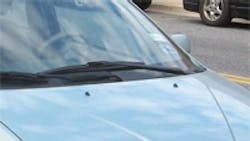In response
The following letters are in response to discussions of Toyota's recent woes, including a story about a runaway Prius in California — a tale that recently turned out to be a hoax. Toyota is in the process of a massive recall effort, which involves unintended acceleration, errant floor mats, or faulty brakes on eight of its models.
Data recorders hold promise
For the last few years, automotive engineers have talked about installing inexpensive “drive recorders” in vehicles, similar to the flight recorders used in aircraft. They would collect data to be examined after an accident so that cars could be better designed.
The lawyers have always objected, citing privacy as the reason. I think the real reason is self-interest. If impartial truth were admitted into evidence, who would need a lawyer? There would be no case, just data.
I think Toyota's engineers and all others would be greatly interested in the truth. Seems like lawyers who were interested in justice instead of more money would feel the same way. So install the data recorders. Get the truth. Make the cars safer.
D. Snoek
Hudsonville, Mich.
Call for infrared spectrum analysis
While Occam's razor would indicate that a hoax or human error is the most likely cause of the runaway Prius carrying James Sikes, a conclusion based on the paucity of released investigative findings would be incompetent at this point. After all, people's lives are involved, and there is a vast amount of potentially pertinent information to be gathered. For example, was the brake fluid checked by infrared spectrum analysis to make sure it did not have a light fraction contaminant that could have formed a large gas bubble in the hydraulic system by inadvertent proximity to something hot (such as a brake pad)?
A Toyota spokesperson made reference to “light pressure” being applied to the brakes numerous times in the minutes prior to the car stopping. What is light pressure? Was a calibration check performed? Can pressure favoring one side of the pedal cause a twisting in a joint or linkage that interferes with force transfer?
Lastly are human factors involving the investigators. Were engineers or other technical team members urged to come up with unlikely yet plausible scenarios that could then be eliminated?
Were people assuming the man was truthful, only to accept the alternate hypothesis when overwhelming evidence pointed that way? Were any of the investigators employed by the U.S. government affected by others who were later hired by Toyota at an increased salary?
In short, this looks like a hoax or case of human error. However, if Toyota doesn't perform a comprehensive investigation, then management just doesn't get it. It would suggest they are willing to let customers risk death rather than competently challenge their own belief system.
Scott Murray
Fremont, Calif.
Avoid mass hysteria
No established connection exists between the New York and California Prius incidents, and they must each be investigated on their own merits. If the science is followed, facts are established, and mass hysteria and political overtures are avoided, the problem will be solved. Instead, mass hysteria and political intervention by people who have no technical ability to understand the problem (and much less solve it) will intervene and declare it solved by legal methods.
Carl Klinge
Vancouver, Wash.
Tape to dashboard
Runaway car? Don't panic, put car in neutral, and apply parking brake. It's not rocket science.
Larry Freet, Prius owner
Drivers are coddled into complacency
Part of the problem is that there is no longer a physical linkage between the accelerator pedal and the actual engine; the other is anti-lock brakes. My first instinct would be to jam the brakes on as hard as possible, causing a lockup, which would stop the car no matter what. With anti-lock, all the brakes do is smoke themselves into uselessness. At what point does the technology become too much and drivers are coddled into complacency, causing them to put too much faith in the safety features built into the car? I prefer a low-tech older car that I have total control over, so I don't plan to buy any car newer than about 1995. I have two of that vintage and so far they are good cars, minus a lot of the stuff meant to protect (or kill?) me.
Bill Baka
Marysville, Calif.
